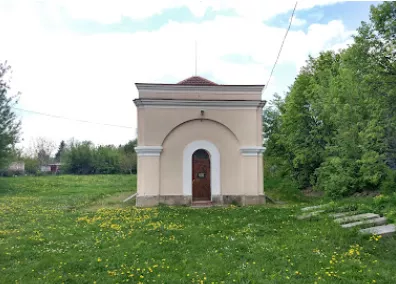Mlynow on the Banks of the Ikva River
By: Yaakov Rosenfeld, Ganzach Kiddush Hashem
The yahrzeit (anniversary of death) of the Karliner Rebbe, Rabbi Aharon II (Sivan 17, 5632/June 23, 1872, 151 years ago) is the time to remember the city of Mlynow, a Jewish city that was destroyed and almost no survivors remained.
The Beit Aharon, as he was known, was on the way to his granddaughter’s wedding, and stopped in the city of Mlynow. Suddenly, he announced “Oh, my sky is cloudy!” He began to prepare for his passing from the world, said viduy (confessional prayer) with concentration, got on a bed, and thus died out of supreme mental preparation and with a clear mind.
The Rebbe already knew before the journey that in the middle of his trip his soul would depart and it would rise in the heavenly storm, for on the last Holy Shabbat he gave explicit words about this, and they appear in the Beit Aharon book on page 114, under the title “The year 5632 on the Holy Shabbat, the week of the Torah portion of Behalotecha before they went to rest, he said…” In his sermon, he spoke about the next world and about the fact that “in its ascension they will travel, when it will be so and so, then it will ‘travel’!”
His only son, his successor Rabbi Asher z”l (cited in the Beit Aharon book, page 157), said that his father said wonderous things to him before he left the world:
Here is more from his son, the Rebbe – words of comfort that he said with tears in his eyes when they came to console him on the passing of his father, the prior Rebbe:
My father, rabbi, and teacher z”l said before he went on his way that he was requested in the Yeshiva Shel Ma’ale (the afterlife), he said to me in this language: At the grave of my father, the holy elder rabbi, the great Rebbe Aharon of Karlin, one should lament and mourn without mourning in an untimely manner, not mourn too much, and not like the memorials in the state of Volhynia, to whom many prostrate themselves in prayer and supplication before G-d, thus he told me with his holy mouth and I understood from his holy words that he wanted people to only pray their on occasion when they were in Volhynia, and this is how his prayer held up…
This is how we understand how the coffin of the tzadik (righteous man) from Karlin arrived in the distant city of Mlynow. Indeed, throughout the years, countless people, women and children flocked to the holy ohel (small building around his grave) in Mlynow, to mark the Rebbe’s death there on the way, and they would weep there for the weight of exile and destruction until the end of Israel’s exile in Europe arrived and all Judaism was furiously destroyed.

According to many testimonies that appear in the Mlynow Yizkor book, miracles were associated to have taken place at the tzaddik’s grave, and magical legends were passed down from father to son about the miraculous manner of his departure from the world and the historic funeral.
And every year, on the 17th day of Sivan, the roads and paths leading to the city of Mlynow were filled with thousands of Jews who came to visit his holy grave. In hard times, tears were shed there, and according to the testimonies of the writers in the above-mentioned Yizkor book, gentiles would also come to pray in the holy place.
The tzaddik from Karlin was known as “the happy tzaddik”, since his whole essence was joy and elation. During the difficult period that the Karliner Rebbe lived and worked in, the Jews suffered from the decrees of the Cantonists, which tore families apart and caused grief and sorrow to countless Jews. At that time, the revered Rebbe was an inexhaustible source of strength and courage for countless people who came to pour out their hearts before the compassionate and tender-hearted Rebbe.
The heavy poverty that oppressed the Jews at that time and their servitude to the kingdoms could not support their cheerful and uplifted spirits.
The Rebbe was both a visible and hidden giant, a servant of G-d, a self-sacrificing individual. His prayers were recited with the fervor of a holy fire and his words of Torah were learned in awe by chassidim and people of faith from his holy book “Beit Aharon.”
By the way, this book was known all over Russia, Ukraine, and Volhynia as a charm that was put on the heads of sick or pregnant women, and Torah elders who were mitnagdim (non-chassidic) also considered it a sacred and accepted charm.
Thousands flocked to the Rebbe of Karlin’s hall during his lifetime, and after his passing, thousands visited his grave in Mlynow until the terrible Holocaust that consumed the old community, among thousands of Jewish communities that were destroyed and cut down to their foundations.
As mentioned, the Ikva River flows through this town, and according to the testimony given in the Mlynow Book, the origin of the river’s name is a miraculous story that happened in Mlynow one year during the melting of the snow, in the month of spring, when the river was wild and threatened to wash away the houses of the town. At that time the Jews gathered in the synagogue and shed tears like water, prayed for the cancellation of the evil decree, and then, as a merit charm, said the verse “Let the waters under the sky gather to one place” (Genesis 1:9), and miraculously the flood stopped and the water calmed down.
And from that time even the gentiles called the river the ‘Ikva” from the verse “ivku hamayim” (gather the waters).
From the testimony of the granddaughter of Rabbi Yitzchak Strasa z”l of Mlynow, Mrs. Sylvia Goldberg from the USA (translated from Yiddish):
“Mlynow meritted to have the bones of the holy Rebbe Aharon of Karlin in its cemetery (…) on his grave an ohel was built, a memorial, to which thousands of Jews flocked throughout the years, until the Nazi occupation.”
“They would come with a broken heart to the tzaddik’s memorial, connect to the memory of him, and appeal with requests and pleas for individual and communal troubles. For many years Rabbi Avraham Holtzes and Rabbi Yitzchak Leib took care of the ohel and the eternal flame there.”
Here the witness describes the story of the righteous man’s passing (mentioned above), as passed down from generation to generation in the town, and adds:
“I remember the date of the 17th of Sivan in Mlynow. The young Stoliner Rebbe would come with chassidim, recite Psalms, and write notes of requests and supplications. Many Jews filled the town at all hours of the day, and Jewish mothers would also prostrate themselves on the memorial, modest women who would cry and tearfully sob their troubles.”
“People came and left the city telling about wonders and miracles that happened to them thanks to the tzaddik…”
“The faith and trust in the power of the tzaddik’s holiness was so strong that even gentiles would came to ask for their needs at the holy memorial and to relieve their troubles.”
“I remember that in the evening many people would gather in the Great Synagogue, they would drink a l’chaim and their hearts would be light… They were sure and calm that their prayers in the holy place would rise to the throne of honor (of G-d).”
Y. Mitelman also described the beauty of the town (ibid., pg. 313), and longingly wrote about the memorial of the tzaddik of Karlin, who was a stronghold for thousands of thousands. He describes the circumstances of Rabbi Aharon’s miraculous death precisely in the city where he never lived, and describes the pure and noble Jews of the town:
“The Jews of Mlynow were G-d fearing Jews, happy with their lot, and satisfied living with less.”
“These were Jews who enjoyed what came their way, and after a hard day’s work, they gathered at the synagogue to study Torah. Some studied Gemara, some studied Chumash (Pentateuch) and the Rashi commentary, and some recited Psalms.”
“Nota Dov Berger stood by the lecturn and studied the holy Zohar, and Rabbi Moshe Aharlis studied Midrash on Shabbat at noon, and beside him sat Nota Miller and Chaim Miller and Nota Sasish with all the craftsmen and blacksmiths, and Rabbi Yehuda Leib studied with people, amongs them was the Or HaChaim book.”
“And I rememver that when Nachman Wallach stood next to the lecturn with his Psalms and the voices emanated out, and Avraham Moshe Aharon sat in the east with his prayer shawl and tefillin and Mordechai Meir Shrentzel was an assistant in the Great Synagogue, and last but not least Chanoch Henich, when he began to pray the Mussaf prayer during the High Holidays and began with the prayer “Hineni Ani” (Here I am poor) we were shaken and afraid – and the walls of the synagogue shook with all the worshippers.”
“Decades have passed since then, but this town with its great people still stands before my eyes.”
“When Chanoch Henich walked to the study hall on Shabbat eve with his long clothing and white socks and a tall hat made of ‘smut’ (a short form for “tzur m’ra v’aseh tov” – “Turn from bad and do good”) and he passed by the shops and said ‘Shabbat! Shabbat!’ So all the people in the stores trembled with fear and immediately closed all the stores.”
“Most of the community observed the mitzvahs of charity and kindness.”
“When they needed to go to the loan society, everyone already knew the locations of Shlomo Zaltkis, and the woman Rachel Shebes, and more. And in the more recent times, there was Zvi Palik and Chaim Yitzchak Kipergluz… and no one said the place was too small for them because hands were open both to charity and kindness.”
“And where were the righteous women of our city, Mlynow?”
“Sheindel, Bluma, Devorah Shnertzel, Mimeh Ita, Mirrel the butcher, Batya the butcher, Runia Rivka who was the wife of Moshe Leib, Ita Gersheins, and my mother, and more and more…”
“I do not have the words in my mouth or on my tongue to describe the chassidim of Karlin…Rabbi Yitzchak Leib the mashgiach (in charge of yeshiva), Avraham Chulis, Shimon Rosenfeld, Tzadok Shulman, Pesach Aharon the tailor and his son Aharon Asher Berel Barben, Yiztchak Strasta and his sons Aharon, Shmuel, Asher, Avremki, and Yidel, and many many more good men…when they began to pray “All My Bones will Say It.”
The bitter end of the Jewish towns of Europe was also the end of the magical Mlynow. The Jews of the town and nearby towns were led to the shooting pits and shot into the pits with unparalleled cruelty.
In the last days of the ghetto, a few of the Jews tried to revolt and even succeeded in obtaining weapons which they placed in the Karliner Rebbe’s ohel, but nothing worked for them and even this hesitant rebellion did not finally come to fruition on the day of the terrible decree, the day of the terrible massacre, in the month of Elul 5703 (Summer 1943), when nearly 1300 were killed, and a little more than fifty Jews who tried to escape and hide were also shot and killed after being sadistically dragged to the same place.
May the souls of the Jews of this magical town be bound in the bond of Life.







